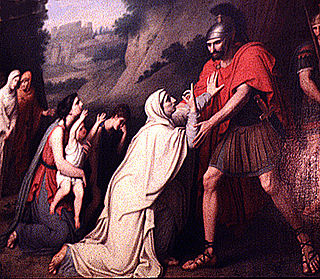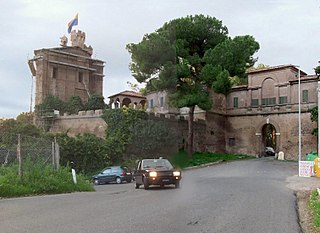Related Research Articles

GnaeusMarcius Coriolanus was a Roman general who is said to have lived in the 5th century BC. He received his toponymic cognomen "Coriolanus" following his courageous actions during a Roman siege of the Volscian city of Corioli. He was subsequently exiled from Rome, and led troops of Rome's enemy the Volsci to besiege the city.
Ferentina was the patron goddess of the city Ferentinum, Latium. She was protector of the Latin commonwealth. She was also closely associated with the Roman Empire.

The Volsci were an Italic tribe, well known in the history of the first century of the Roman Republic. At the time they inhabited the partly hilly, partly marshy district of the south of Latium, bounded by the Aurunci and Samnites on the south, the Hernici on the east, and stretching roughly from Norba and Cora in the north to Antium in the south. Rivals of Rome for several hundred years, their territories were taken over by and assimilated into the growing republic by 304 BC. Rome's first emperor Augustus was of Volscian descent.

The Battle of Lake Regillus was a legendary Roman victory over the Latin League shortly after the establishment of the Roman Republic and as part of a wider Latin War. The Latins were led by an elderly Lucius Tarquinius Superbus, the seventh and last King of Rome, who had been expelled in 509 BC, and his son-in-law, Octavius Mamilius, the dictator of Tusculum. The battle marked the final attempt of the Tarquins to reclaim their throne. According to legend, Castor and Pollux fought on the side of the Romans.

Lavinium was a port city of Latium, 6 km (3.7 mi) to the south of Rome, midway between the Tiber river at Ostia and Antium. The coastline then, as now, was a long strip of beach. Lavinium was on a hill at the southernmost edge of the Silva Laurentina, a dense laurel forest, and the northernmost edge of the Pontine Marshes, a vast malarial tract of wetlands. The basis for the port, the only one between Ostia and Antium, was evidently the mouth of the Numicus river.

Antium was an ancient coastal town in Latium, south of Rome. An oppidum was founded by people of Latial culture, then it was the main stronghold of the Volsci people until it was conquered by the Romans.

Norba, an ancient town of Latium (Adjectum), Italy. It is situated 1 mile northwest of the modern town of Norma, on the western edge of the Volscian Mountains or Monti Lepini. The town is perched above a precipitous cliff with a splendid view over the Pomptine Marshes below; the highest point stands to ca. 460 meters above sea level.
Corioli was a town in ancient times in the territory of the Volsci in central Italy, in Latium adiectum.

Cori is a city and comune in the province of Latina, in the Lazio region of central Italy.
Postumus Cominius Auruncus was a two-time consul of the early Roman Republic.
The Roman conquest of the Hernici, an ancient Italic people, took place during the 4th century BC. For most of the 5th century BC, the Roman Republic had been allied with the other Latin states and the Hernici to successfully fend off the Aequi and the Volsci. In the early 4th century BC, this alliance fell apart. A war fought between Rome and the Hernici in the years 366–358 BC ended in Roman victory and the submission of the Hernici. Rome also defeated a rebellion by some Hernician cities in 307–306 BC. The rebellious Hernici were incorporated directly into the Roman Republic, while those who had stayed loyal retained their autonomy and nominal independence. In the course of the following century, the Hernici became indistinguishable from their Latin and Roman neighbours and disappeared as a separate people.
The Roman-Aequian wars were a series of wars during the early expansion of ancient Rome in central Italy fought against the Aequi, an Italic tribe located to their east.
Pollusca was a town in ancient times in the territory of the Volsci in central Italy. It was located south of Rome, north of the Volscian capital Antium, and just west of Corioli.
Corbio was an ancient town of Latium in central Italy.
Lavici was an ancient town of Latium in central Italy, located near modern Colonna.
Pedum was an ancient town of Latium in central Italy, located between Tibur and Praeneste, near modern Gallicano nel Lazio. The town was a member of the Latin League.
Lucius Aemilius Mamercus was a Roman statesman who served as consul three times: in 484, 478 and 473 BC.
Servius Sulpicius Camerinus Cornutus was a Roman politician in the 5th century BC, consul in 461 BC and decemvir in 451 BC.
Titus Veturius Geminus Cicurinus was a Roman politician of the 5th century BC, consul in 462 BC and maybe decemvir in 451 BC.
Marcus Valerius Poplicola was a politician of the Roman Republic who served as magister equitum under the dictator Gaius Sulpicius Peticus in 358 and as consul in 355 and 353 BC.
References
- ↑ Purcell, N., R. Talbert, S. Gillies, T. Elliott, J. Becker (April 2022). "Places: 438775 (Longula)". Pleiades. Retrieved October 21, 2015.
{{cite web}}: CS1 maint: multiple names: authors list (link) - ↑ Antonio Nibby (1837). Analisi storico-topografico-antiquaria della carta de'dintorni di Roma. pp. 748–.
- ↑ Livy, Ab urbe condita , 2.33
- ↑ Comitato per l'archeologia laziale. Incontro di studio (1983). Archeologia laziale. Consiglio nazionale delle ricerche.
- ↑ Livy, Ab urbe condita , 2.39